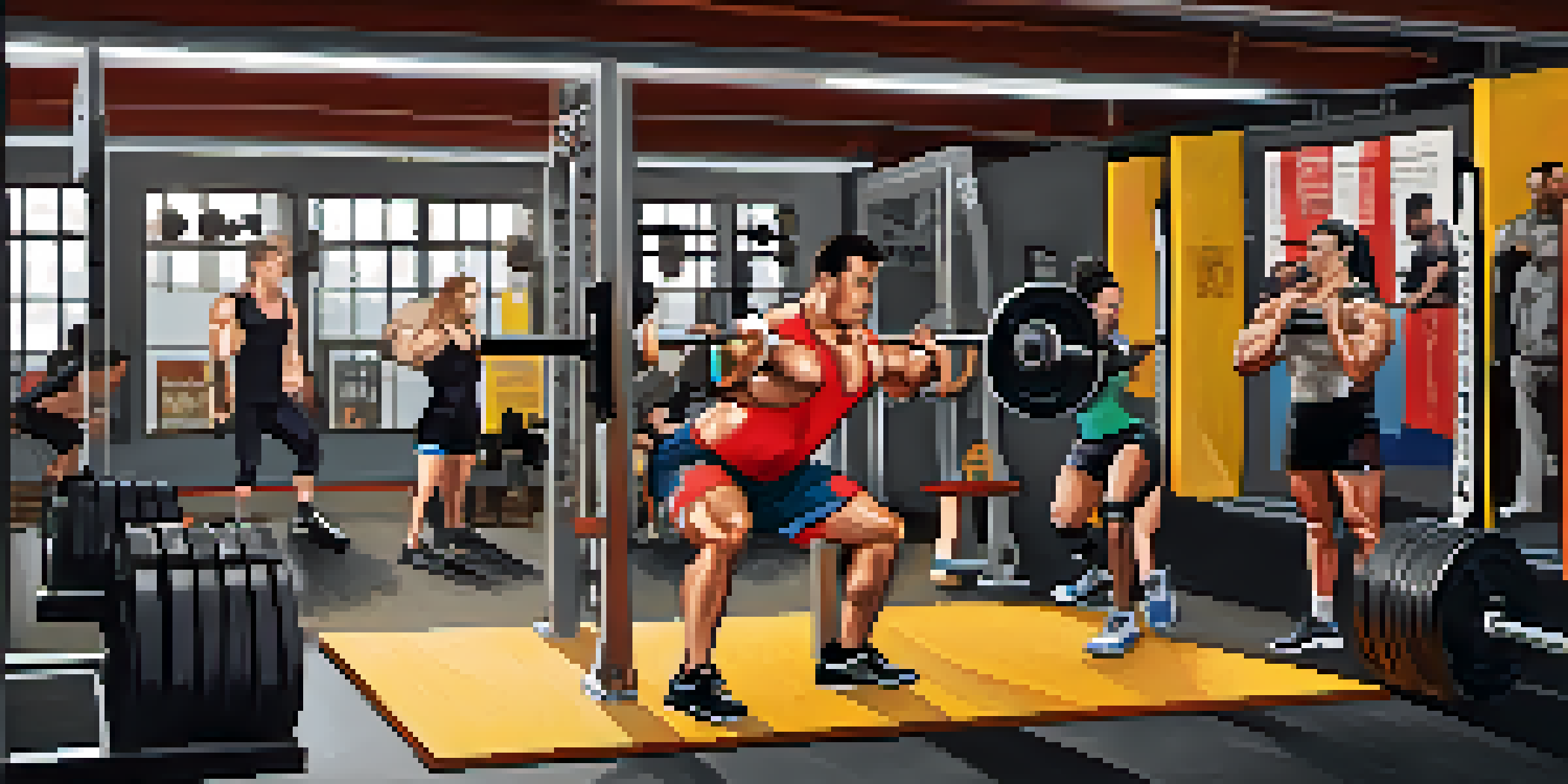Powerlifting and Body Composition: A Comprehensive Overview

Understanding Powerlifting: Basics and Benefits
Powerlifting is a strength sport that focuses on three main lifts: the squat, bench press, and deadlift. Each lift tests different muscle groups and overall strength, making it a comprehensive workout. The goal is to lift the maximum weight possible in these three lifts, which not only builds muscle but also improves functional strength.
Strength does not come from physical capacity. It comes from an indomitable will.
One of the unique benefits of powerlifting is its emphasis on form and technique. This focus helps prevent injuries and ensures that lifters are engaging the correct muscles. As you improve your technique, you'll notice not just strength gains but also better body mechanics in everyday activities.
Moreover, powerlifting has a supportive community that encourages participants of all levels. Whether you're a beginner or an experienced lifter, you'll find camaraderie at local gyms and competitions. This environment can be motivating and can significantly enhance your fitness journey.
The Connection Between Powerlifting and Body Composition
Body composition refers to the proportions of fat, muscle, bone, and other tissues in your body. Powerlifting can positively influence your body composition by increasing muscle mass and reducing body fat, especially when paired with a proper diet. This shift not only enhances physical appearance but also boosts metabolism.

When you lift heavy weights, your muscles undergo stress, leading to micro-tears. As these tears heal, your muscles grow larger and stronger, contributing to improved body composition. This process, known as hypertrophy, is essential for anyone looking to increase their muscle mass and reduce fat.
Powerlifting Builds Strength & Confidence
Powerlifting emphasizes proper technique and form, helping to prevent injuries and improve everyday functional strength.
Additionally, the increase in muscle mass can improve your resting metabolic rate. More muscle means your body burns more calories, even at rest. This makes it easier to manage body fat levels while still enjoying the benefits of strength training.
Nutrition: Fueling Your Powerlifting Journey
Nutrition plays a critical role in powerlifting and body composition. Proper fueling ensures that you have the energy required for intense training sessions and recovery. A balanced diet rich in proteins, carbohydrates, and healthy fats will provide the necessary nutrients to support muscle growth and overall health.
The difference between a successful person and others is not a lack of strength, not a lack of knowledge, but rather a lack in will.
Protein is particularly important for powerlifters, as it aids in muscle repair and growth. Aim for a protein-rich meal after your workouts to maximize recovery. Foods such as chicken, fish, beans, and dairy can help meet your protein needs and enhance your performance in the gym.
Carbohydrates are also essential, as they provide the energy needed for lifting heavy weights. Including complex carbs like whole grains, fruits, and vegetables in your meals will help maintain energy levels. This combination of protein and carbs can significantly improve your lifting capacity and body composition.
The Role of Recovery in Powerlifting Success
Recovery is an often-overlooked aspect of powerlifting that can greatly impact your body composition. Muscles need time to repair and grow after intense workouts, and neglecting recovery can hinder progress. Incorporating rest days and active recovery sessions into your routine can help optimize your results.
Sleep is another vital component of recovery. Aim for 7-9 hours of quality sleep each night to allow your body to repair itself effectively. Poor sleep can lead to increased stress hormones, which may hinder muscle growth and fat loss, ultimately affecting your body composition.
Nutrition Fuels Powerlifting Success
A balanced diet rich in protein and carbohydrates is essential for energy, muscle growth, and optimal performance in powerlifting.
Additionally, consider including practices such as stretching, foam rolling, and even meditation to enhance recovery. These activities can reduce muscle soreness and improve overall flexibility, allowing you to lift more effectively in subsequent workouts.
Powerlifting Techniques to Enhance Body Composition
Incorporating specific techniques into your powerlifting routine can enhance body composition. For instance, focusing on compound movements, which engage multiple muscle groups, can lead to more significant muscle growth and fat loss. Squats, deadlifts, and bench presses are excellent examples of these movements.
Additionally, varying your training intensity and volume can further optimize body composition. Implementing cycles of heavy lifting, followed by lighter sessions, can prevent plateaus and promote continuous muscle growth. This strategy keeps your body guessing and adapts to the training stimulus over time.
Lastly, consider integrating accessory exercises that target weaker areas. Strengthening these muscles can improve your overall lifts, which in turn can enhance body composition. For example, adding rows and overhead presses to your routine can help build a balanced physique.
Common Misconceptions About Powerlifting and Body Composition
Many people believe that powerlifting leads to excessive muscle gain and unwanted bulk, which isn't necessarily true. While it is possible to gain muscle, the key to achieving your desired body composition lies in the balance of nutrition and training. With the right approach, powerlifting can help anyone achieve a leaner physique.
Another misconception is that powerlifting is only for those who want to compete. In reality, powerlifting can benefit anyone looking to improve their strength and fitness level. You don't have to lift excessively heavy weights; focusing on form and gradually increasing your load can yield excellent results.
Recovery is Key to Muscle Growth
Incorporating adequate recovery, including sleep and active rest, is crucial for muscle repair and overall progress in powerlifting.
Lastly, many assume that powerlifting requires a specific body type. The beauty of this sport is that it’s inclusive, welcoming individuals of all shapes and sizes. With dedication and perseverance, anyone can excel in powerlifting and improve their body composition.
Getting Started with Powerlifting for Better Body Composition
If you're interested in powerlifting, the first step is to find a gym that supports this type of training. Look for facilities that have the necessary equipment, like squat racks and benches, and offer a supportive community. Many gyms also have experienced trainers who can guide you through your powerlifting journey.
Before you jump in, it’s essential to learn proper lifting techniques. Consider taking classes or working with a coach to establish a solid foundation. This investment in learning will not only enhance your performance but also reduce the risk of injury.

Finally, set realistic goals for your powerlifting journey. Whether you aim to lift a certain weight or improve your body composition, having clear objectives can motivate you. Remember to celebrate your progress along the way, as every small victory counts in the pursuit of strength and better body composition.